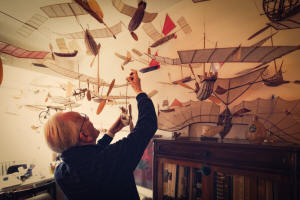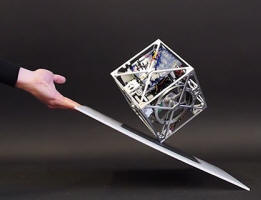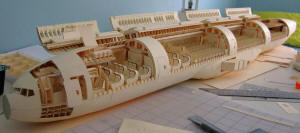|
This is Colossal, really,
it is. That's the name of a website that features, among other things, amazing works
of art with high technology themes. There are hundreds of pages containing thousands
of images, so after spending an inordinate amount of time sifting through pages
in an orderly manner looking for for items of interest, I finally discovered the
Search box. I then spent my valuable time looking only of for topics like radio,
technology, computers, etc.
This first example, titled "Antenna Telescopes on the Streets of Birmingham,
UK," is classified loosely as street art and was done to camouflage some satellite
television dishes mounted to the side of a building. It would be interesting to
see if the artist (unknown) planned for the images to look right from many different
perspectives, not just the optimal one shown.
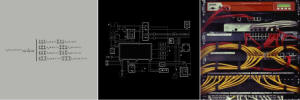 "The Beauty of Mathematics: A Visual
Demonstration of Math in Everyday Life" (thisiscolossal.com)
|
Next up is one called "The Beauty of Mathematics: A Visual Demonstration of Math
in Everyday Life," from Parachutes.tv
(not much else good there IMHO). It is a video that shows many common type
processes and events with a 3-panel display for each one. The leftmost panel has
the governing equations, the center panel has a graphical simulation running based
on the equations, and the rightmost panel shows the actual subject in situ. It is
not necessarily awe-inspiring, but is a unique juxtapositioning of the science and
mathematics behind events like a chemical reaction, airflow around an airfoil, computer
code execution, a top spinning, etc.
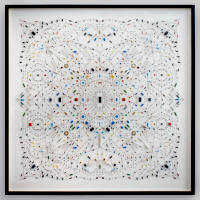 "Technological
Mandalas Made from Soldered Computer and Radio Components" (thisiscolossal.com) |
 Sharpen your pencils (or your circuit simulator)
for "Technological Mandalas Made from Soldered Computer and Radio Components." The
challenge here is to determine the complex impedance of the circuit between any
two adjacent corners and across opposing corners. Writing the mesh equation would
be a work of art in and of itself! The matrix would be hundreds of elements per
side. A mandala, in case you are not familiar with the term, is a Sanskrit word
for "circle," and is a spiritual and ritual symbol in Hinduism and Buddhism representing
the Universe. I saw a video once of Buddhists creating them from colored sand -
amazing. These by Leonardo Ulian
utilize electronics components like resistors, inductors, capacitors, integrated
circuits, ferrites, etc., to create symmetrical patterns. Sharpen your pencils (or your circuit simulator)
for "Technological Mandalas Made from Soldered Computer and Radio Components." The
challenge here is to determine the complex impedance of the circuit between any
two adjacent corners and across opposing corners. Writing the mesh equation would
be a work of art in and of itself! The matrix would be hundreds of elements per
side. A mandala, in case you are not familiar with the term, is a Sanskrit word
for "circle," and is a spiritual and ritual symbol in Hinduism and Buddhism representing
the Universe. I saw a video once of Buddhists creating them from colored sand -
amazing. These by Leonardo Ulian
utilize electronics components like resistors, inductors, capacitors, integrated
circuits, ferrites, etc., to create symmetrical patterns.
"Ships That Sail Through the Clouds" is near and dear to my heart since it features
stick-and-tissue model aircraft. The designs are more Da Vinci-esque than real
flying machines, but they capture the essence of manned flight. 83-year-old architect
and modeler Luigi Prina (warning: audio
will play automatically on his website) built the craft and the display. Many feature
boat hulls with aeroplane flying surfaces and airscrews for propulsion rather than
water screws (propellers). Sì, in effetti, gli italiani e le loro macchine volanti
- si devono amarli(Google
translation). I would not want to be responsible for keeping the dust cleared
off all those models!
The subject with the biggest cool factor has to be the "The Cubli: A Gravity-Defying
Cube that Can Jump, Balance, and Walk." It is a motorized, computerized, wirelessly
controlled gyroscopic platform that can motivate itself and perform seemingly gravity-defying
antics. It can roll - in a cubic manner - up an inclined plane or instantly spring
from sitting flat on a surface to standing on a corner without any means of support.
Manipulating the spinning masses (gyroscopes) about the three orthogonal axes accomplishes
the feats. Gyroscopic stabilization and precession are the motivating forces. This
would make a great geek "toy" if some enterprising person were to productize it
and get one of the Chinese manufacturers of radio controlled model helicopters and
multicopters (aka drones) to produce them cheaply. Don't be surprised if the Cubli's
creators at the Institute for Dynamic Systems
and Control, ETH Zurich, Switzerland eventually do just that.
 "Circuit Scribe: Instantly
Draw Functional Electrical Circuits on a Piece of Paper" (thisiscolossal.com) |
In college physics laboratory back in the 1980s, I remember using a pen with
conductive ink to draw patterns on lightweight cardboard, connecting a DC voltage
supply to them, and then sprinkling iron filings onto board. Lines of magnetic force
would thus be revealed. We would sketch out the field lines onto the cardboard and
then, using our learned knowledge, sketch equipotential electric force lines perpendicular
to the magnetic force lines (or rather what would be if the magnetic field were
to change). Amazingly, the resulting pictures resembled results predicted by the
governing equations. Unlike today's physics classes where computer simulations quickly
and effortlessly (for the operator) produce precise pictures, ours were generated
with pencil on graph paper after manually calculating (with, admittedly the help
of an electronic calculator, not a slide rule) the x-y coordinates in 2 dimensions
for a set of points. But, I digress. What is shown here in "Circuit Scribe: Instantly
Draw Functional Electrical Circuits on a Piece of Paper," is not field lines but
sketched conductive lines used to effect connections for completing functional circuits.
Circuit Scribe creators raised an astounding $624,475 in a Kickstarter campaign
to develop a retail product for the STEM (Science,
Technology, Engineering and Math) educational market. If you want to make a fortune
these days, find a way to sell into the government purchasing system - it has a
money printing machine (the Fed) with
an unlimited reserve of funds.
Finally, in a display of unbelievable talent, is "A 1:60-Scale Boeing 777 Built
Entirely from Paper Manilla[sic] Folders". San Francisco-based designer Luca Iaconi-Stewart
built the model over a 5-year time period. Did I mention that Luca was a junior
in high school when he began the project? Once again I feel like a low achiever.
Relying on detailed schematics of an Air India 777-300ER he found online, he created
digital versions in Adobe Illustrator and then printed them directly onto the manila
folders and the cut them out. The turbine engines have fully functional thrust reversers,
cargo loading doors have functional hinges, and the cockpit is fully detailed. Manila
(not 'manilla') folders, BTW, derive their name from the capital of the Philippines,
where hemp from the abacá
tree was originally used for the paper (no, you
Coloradans can't roll the 777 and smoke it).
Posted February 9, 2014
|































